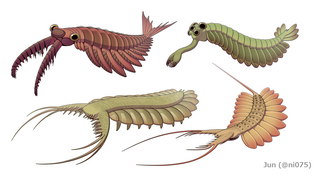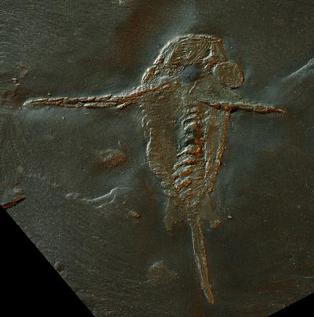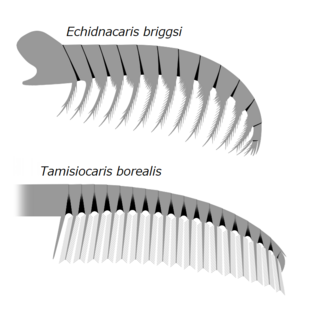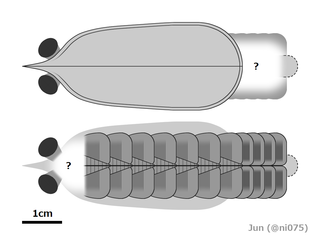
Lobopodians are members of the informal group Lobopodia, or the formally erected phylum Lobopoda Cavalier-Smith (1998). They are panarthropods with stubby legs called lobopods, a term which may also be used as a common name of this group as well. While the definition of lobopodians may differ between literatures, it usually refers to a group of soft-bodied, marine worm-like fossil panarthropods such as Aysheaia and Hallucigenia.

Opabinia regalis is an extinct, stem group arthropod found in the Middle Cambrian Burgess Shale Lagerstätte of British Columbia. Opabinia was a soft-bodied animal, measuring up to 7 cm in body length, and its segmented trunk had flaps along the sides and a fan-shaped tail. The head shows unusual features: five eyes, a mouth under the head and facing backwards, and a clawed proboscis that probably passed food to the mouth. Opabinia probably lived on the seafloor, using the proboscis to seek out small, soft food. Fewer than twenty good specimens have been described; 3 specimens of Opabinia are known from the Greater Phyllopod bed, where they constitute less than 0.1% of the community.

Dinocaridida is a proposed fossil taxon of basal arthropods that flourished in the Cambrian period with occasional Ordovician and Devonian records. Characterized by a pair of frontal appendages and series of body flaps, the name of Dinocaridids refers to the suggested role of some of these members as the largest marine predators of their time. Dinocaridids are occasionally referred to as the 'AOPK group' by some literatures, as the group compose of Radiodonta, Opabiniidae, and the "gilled lobopodians" Pambdelurion and Kerygmachelidae. It is most likely paraphyletic, with Kerygmachelidae and Pambdelurion more basal than the clade compose of Opabiniidae, Radiodonta and other arthropods.

Anomalocarididae is an extinct family of Cambrian radiodonts, a group of stem-group arthropods.

Kerygmachela kierkegaardi is a kerygmachelid gilled lobopodian from the Cambrian Stage 3 aged Sirius Passet Lagerstätte in northern Greenland. Its anatomy strongly suggests that it, along with its relative Pambdelurion whittingtoni, was a close relative of radiodont and euarthropods. The generic name "Kerygmachela" derives from the Greek words Kerygma (proclamation) and Chela (claw), in reference to the flamboyant frontal appendages. The specific name, "kierkegaardi" honors Danish philosopher Søren Kierkegaard.

Pambdelurion is an extinct genus of panarthropod from the Cambrian aged Sirius Passet site in northern Greenland. Like the morphologically similar Kerygmachela from the same locality, Pambdelurion is thought to be closely related to arthropods, combining characteristics of "lobopodians" with those of primitive arthropods.

Parapeytoia is a genus of Cambrian arthropod. The type and only described species is Parapeytoia yunnanensis, lived over 518 million years ago in the Maotianshan shales of Yunnan, China. Unidentified fossils from the same genus also had been discovered from the nearby Wulongqing Formation.

Megacheira is an extinct class of predatory arthropods defined by their possession of spined "great appendages". Their taxonomic position is controversial, with studies either considering them stem-group euarthropods, or stem-group chelicerates. The homology of the great appendages to the cephalic appendages of other arthropods is also controversial. Uncontested members of the group were present in marine environments worldwide from the lower to middle Cambrian.

Schinderhannes bartelsi is a species of hurdiid radiodont (anomalocaridid) known from one specimen from the lower Devonian Hunsrück Slates. Its discovery was astonishing because previously, radiodonts were known only from exceptionally well-preserved fossil beds (Lagerstätten) from the Cambrian, 100 million years earlier.

Haikoucaris is a genus of megacheiran arthropod that contains the single species Haikoucaris ercaiensis. It was discovered in the Cambrian Chengjiang biota of China.

Occacaris oviformis is an extinct nektonic predatory arthropod from the Lower Cambrian Maotianshan shale Lagerstätte. It bears a superficial resemblance to the Cambrian arthropod, Canadaspis, though, was much smaller, and had a pair of "great appendages", with which it may have grasped prey. It was originally considered to belong to Megacheira, however it is questioned in later study.

Radiodonta is an extinct order of stem-group arthropods that was successful worldwide during the Cambrian period. They may be referred to as radiodonts, radiodontans, radiodontids, anomalocarids, or anomalocaridids, although the last two originally refer to the family Anomalocarididae, which previously included all species of this order but is now restricted to only a few species. Radiodonts are distinguished by their distinctive frontal appendages, which are morphologically diverse and used for a variety of functions. Radiodonts included the earliest large predators known, but they also included sediment sifters and filter feeders. Some of the most famous species of radiodonts are the Cambrian taxa Anomalocaris canadensis, Hurdia victoria, Peytoia nathorsti, Titanokorys gainessii, Cambroraster falcatus and Amplectobelua symbrachiata, the Ordovician Aegirocassis benmoulai and the Devonian Schinderhannes bartelsi.

Hurdia is an extinct genus of hurdiid radiodont that lived 505 million years ago during the Cambrian Period. Fossils have been found in North America, China and the Czech Republic.

Stanleycaris is an extinct, monotypic genus of hurdiid radiodont from the middle Cambrian (Miaolingian). The type species is Stanleycaris hirpex. Stanleycaris was described from the Stephen Formation near the Stanley Glacier and Burgess Shale locality of Canada, as well as Wheeler Formation of United States. The genus was characterized by the rake-like frontal appendages with robust inner spines.

Caryosyntrips ("nutcracker") is an extinct genus of stem-arthropod which known from Canada, United States and Spain during the middle Cambrian.

Tamisiocarididae is a family of radiodonts, extinct marine animals related to arthropods, that bore finely-spined appendages that were presumably used in filter-feeding. When first discovered, the clade was named Cetiocaridae after a speculative evolution artwork, Bearded Ceticaris by John Meszaros, that depicted a hypothetical filter-feeding radiodont at a time before any were known to exist. However, the family name was not valid according to the International Code of Zoological Nomenclature, as no real genus named "Cetiocaris" exists, and in 2019 it was formally replaced by the name Tamisiocarididae, after the only valid genus of the clade at the time. The family is only known from Series 2 of the Cambrian, unlike other radiodont families, which persisted longer into the Cambrian. All known species would have lived in tropical or subtropical waters, suggesting a preference for warmer waters.

Aegirocassis is an extinct genus of giant radiodont arthropod belonging to the family Hurdiidae that lived 480 million years ago during the early Ordovician in the Fezouata Formation of Morocco. It is known by a single species, Aegirocassis benmoulai. Van Roy initiated scientific study of the fossil, the earliest known of a "giant" filter-feeder discovered to date. Aegirocassis is considered to have evolved from early predatory radiodonts. This animal is characterized by its long, forward facing head sclerite, and the endites on its frontal appendages that bore copious amounts of baleen-like auxiliary spines. This animal evolving filter-feeding traits was most likely a result of the Great Ordovician Biodiversification Event, when environmental changes caused a diversification of plankton, which in turn allowed for the evolution of new suspension feeding lifeforms. Alongside the closely related Pseudoangustidontus, an unnamed hurdiid from Wales, the middle Ordovician dinocaridid Mieridduryn, and the Devonian hurdiid Schinderhannes this radiodont is one of the few known dinocaridids known from post-Cambrian rocks.

Houcaris is a possibly paraphyletic radiodont genus, tentatively assigned to either Amplectobeluidae, Anomalocarididae or Tamisiocarididae, known from Cambrian Series 2 of China and the United States. It contains two species, Houcaris saron and Houcaris magnabasis, both of which were originally named as species of the related genus Anomalocaris. The genus Houcaris was established for the two species in 2021 and honors Hou Xianguang, who had discovered and named the type species Anomalocaris saron in 1995 along with his colleagues Jan Bergström and Per E. Ahlberg.

Hallucigeniidae is a family of extinct worms belonging to the group Lobopodia that originated during the Cambrian explosion. It is based on the species Hallucigenia sparsa, the fossil of which was discovered by Charles Doolittle Walcott in 1911 from the Burgess Shale of British Columbia. The name Hallucigenia was created by Simon Conway Morris in 1977, from which the family was erected after discoveries of other hallucigeniid worms from other parts of the world. Classification of these lobopods and their relatives are still controversial, and the family consists of at least four genera.

Erratus is an extinct genus of marine arthropod from the Cambrian of China. Its type and only species is Erratus sperare. Erratus is likely one of the most basal known arthropods, and its discovery has helped scientists understand the early evolution of arthropod trunk appendages. Some of the stem-arthropods like radiodonts did not have legs, instead they had flap like appendages that helped them swim. Erratus on the other hand had not only flaps but also a set of primitive legs. It also supported the theory that the gills of aquatic arthropods probably evolved into the wings and lungs of terrestrial arthropods later in the Paleozoic.





















